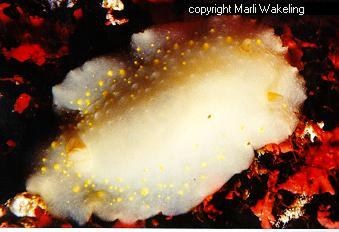
Cadlina modesta
Macfarland, 1966
Order: NUDIBRANCHIA
Suborder: DORIDINA
Superfamily: EUDORIDOIDEA
Family: Chromodorididae
DISTRIBUTION
British Columbia to California.
PHOTO
On red algae, 15 ft. Campbell River, Vancouver Island, British Columbia, Canada. Photo: Marli Wakeling.
Characterised by band of yellow spots (mantle glands) around mantle skirt some distance in for the edge. Grows to about 30mm.
See Jeff Goddard's message on feeding.
Reference:
• MacFarland, F.M. (1966) Studies of opisthobranchiate mollusks of the Pacific coast of North America. Memoirs of the California Academy of Sciences, 6: 1-546.
Rudman, W.B., 2000 (June 4) Cadlina modesta Macfarland, 1966. [In] Sea Slug Forum. Australian Museum, Sydney. Available from http://www.seaslugforum.net/find/cadlmode
Related messages
Cadlina modesta from British Columbia
July 7, 2006
From: Jackie Hildering
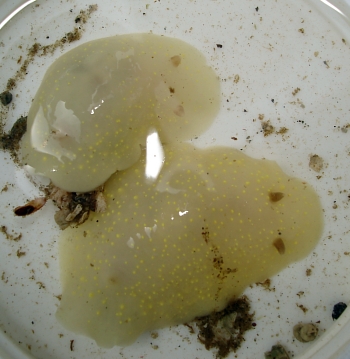
I came across these two animals while on a beach walk with a gang of students. The animals were well camoflaged on a shell bottom in only about 4 cm of water. To give an idea of size, the specimen bottle lid in which I placed them (see photograph) has a diameter of 6 cm.
As an avid diver (and nudibranch fan) in this same area, I have never seen this species before. My only attempt at an id would be to think it may be of the genus Cadlina.
Locality: Port Hardy - Intertidal, Intertidal - 4 cm, British Columbia, Canada, Port Hardy Bay, 17 May 2006, Intertidal. Length: 3 to 4 cm . Photographer: Jackie Hildering.
Any help with identification would be hugely appreciated!
Jackie Hildering
econauts@telus.net
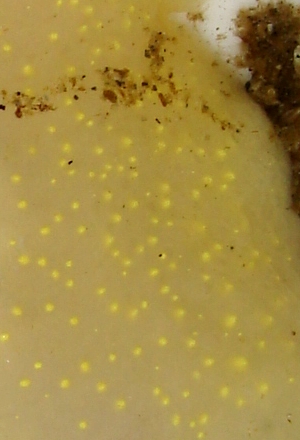
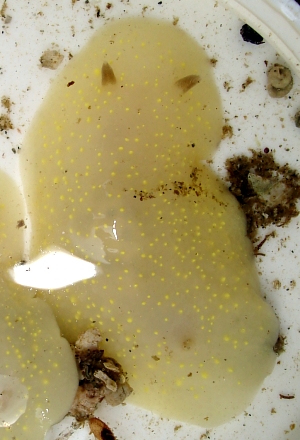
Hi Jackie,
This is a fairly typical Cadlina modesta. The yellow-orange rhinophores and yellow spots on a white dorsum, are the key characters. This is an intertidal species, and feeds on sponges.
In individuals in the southern end of its geographic range, the yellow spots near the margin may be larger than those seen medially.
Thanks for sharing this one,
Dave Behrens
Sponge prey of Cadlina modesta
June 16, 2000
From: Jeff Goddard
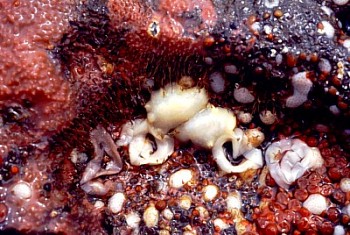
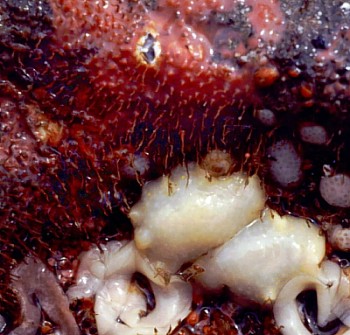
Hi Bill,
Here is a photo of Cadlina modesta on one of the sponges it eats, along with some information on its diet, to go with your recent listing of this species in the Forum.
Cadlina modesta preys exclusively on the dendroceratid sponges, Aplysilla glacialis, and Halisarca sp. (McDonald & Nybakken, 1978; Goddard, 1984, 1998, unpublished observations). In laboratory preference tests in a modified Y maze, it showed a strong preference for A. glacialis over Halisarca sp. (Goddard, unpublished observations).
The photograph shows two Cadlina modesta and their egg masses on a partially grazed patch of Aplysilla glacialis. The hair-like vertical spongin fibers mark where the sponge has been grazed. Also present are the white colonies of the octocoral Alcyonium rudyi Verseveldt & van Ofwegen, 1992 (a prey species of Tritonia festiva) and the orange colored "social" ascidians Metandrocarpa taylori. Underside of an intertidal boulder, North Cove, Cape Arago, Oregon, 27 May 1985.
Interestingly, all 4 species of Cadlina known from the northeastern Pacific are known to prey on Aplysilla glacialis. Cadlina sparsa and C. flavomaculata, so far as is known, specialize on this species; as mentioned above, C. modesta prefer it; and C. luteomarginata appear to prefer it as well, but also prey on many species of spiculate sponges (McDonald & Nybakken, 1978; Goddard, 1984, 1998, 2000, unpublished observations).
References:
• Goddard, J.H.R. (1984) The opisthobranchs of Cape Arago, Oregon, with notes on their biology and a summary of benthic opisthobranchs known from Oregon. The Veliger, 27: 143-163
• Goddard, J.H.R. (1998) A summary of the prey of nudibranch molluscs from Cape Arago, Oregon. Opisthobranch Newsletter, 24: 11-14.
• Goddard, J. 2000. Sponge prey of Chromodoris macfarlandi. Opisthobranch Newsletter, 26: 9-10.
• McDonald, G.R. & J.W. Nybakken. (1978) Additional notes on the food of some California nudibranchs with a summary of known food habits of California species. The Veliger, 21: 110-119.
Best wishes,
Jeff Goddard
goddard@lifesci.ucsb.edu
Goddard, J., 2000 (Jun 16) Sponge prey of Cadlina modesta. [Message in] Sea Slug Forum. Australian Museum, Sydney. Available from http://www.seaslugforum.net/find/2579Dear Jeff,
Thanks for the photo. I've included an enlargement to show the fibres more clearly. I don't know what the chromodorids would have done without the aplysillids and there relatives. Certainly the 'softer' non-spiculate food they provide has allowed the chromodorids to either retain or develop (depending on the primitive state) quite a variety of denticles and cusps on their radular teeth, for which we as taxonomists should be enormously grateful, for the radular morphology of chromodorids is a very useful character.
Best wishes,
Bill Rudman.
Cadlina modesta from British Columbia
June 15, 2000
From: Marli Wakeling

Dear Bill,
Here is Cadlina modesta. This is the only time I've seen this animal. Very shallow, 15 foot safety stop, grazing quickly on red algae. Found in Campbell River, B.C., on Vancouver Island. [British Columbia, Canada].
Marli Wakeling
scubamarli@excite.com
Wakeling, M., 2000 (Jun 15) Cadlina modesta from British Columbia. [Message in] Sea Slug Forum. Australian Museum, Sydney. Available from http://www.seaslugforum.net/find/2503Thanks Marli,
Cadlina is a sponge feeder, so although it would have been crawling over red algae it would not have been grazing on it.
Best wishes,
Bill Rudman.
